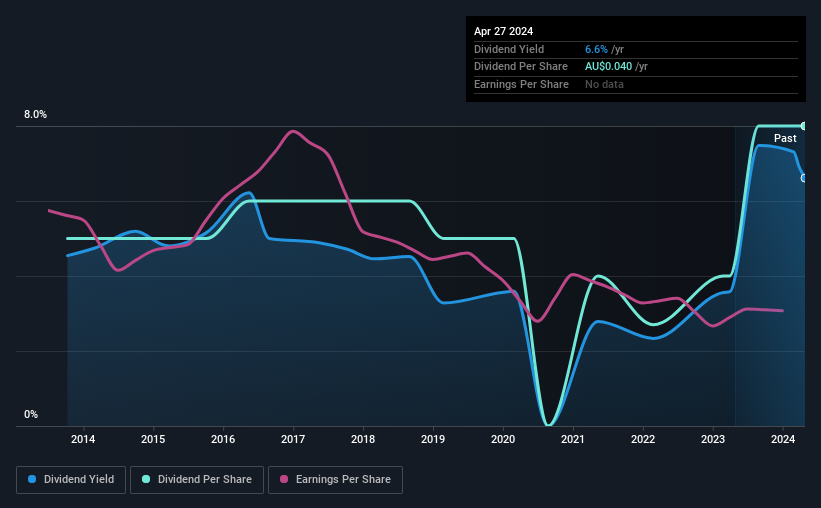United Overseas Australia (ASX:UOS) Is Paying Out A Dividend Of A$0.02
The board of United Overseas Australia Ltd (ASX:UOS) has announced that it will pay a dividend of A$0.02 per share on the 6th of June. This makes the dividend yield 6.6%, which will augment investor returns quite nicely.
See our latest analysis for United Overseas Australia
United Overseas Australia's Payment Has Solid Earnings Coverage
While it is great to have a strong dividend yield, we should also consider whether the payment is sustainable. The last payment made up 80% of earnings, but cash flows were much higher. In general, cash flows are more important than earnings, so we are comfortable that the dividend will be sustainable going forward, especially with so much cash left over for reinvestment.
If the company can't turn things around, EPS could fall by 7.5% over the next year. However, if the dividend continues along recent trends, we estimate the payout ratio could reach 88%, meaning that most of the company's earnings is being paid out to shareholders.
Dividend Volatility
The company's dividend history has been marked by instability, with at least one cut in the last 10 years. Since 2014, the annual payment back then was A$0.025, compared to the most recent full-year payment of A$0.04. This means that it has been growing its distributions at 4.8% per annum over that time. It's encouraging to see some dividend growth, but the dividend has been cut at least once, and the size of the cut would eliminate most of the growth anyway, which makes this less attractive as an income investment.
Dividend Growth Is Doubtful
Growing earnings per share could be a mitigating factor when considering the past fluctuations in the dividend. In the last five years, United Overseas Australia's earnings per share has shrunk at approximately 7.5% per annum. Declining earnings will inevitably lead to the company paying a lower dividend in line with lower profits.
Our Thoughts On United Overseas Australia's Dividend
In summary, while it's good to see that the dividend hasn't been cut, we are a bit cautious about United Overseas Australia's payments, as there could be some issues with sustaining them into the future. The payments haven't been particularly stable and we don't see huge growth potential, but with the dividend well covered by cash flows it could prove to be reliable over the short term. We would be a touch cautious of relying on this stock primarily for the dividend income.
Investors generally tend to favour companies with a consistent, stable dividend policy as opposed to those operating an irregular one. At the same time, there are other factors our readers should be conscious of before pouring capital into a stock. Just as an example, we've come across 4 warning signs for United Overseas Australia you should be aware of, and 1 of them is a bit concerning. Looking for more high-yielding dividend ideas? Try our collection of strong dividend payers.
Have feedback on this article? Concerned about the content? Get in touch with us directly. Alternatively, email editorial-team (at) simplywallst.com.
This article by Simply Wall St is general in nature. We provide commentary based on historical data and analyst forecasts only using an unbiased methodology and our articles are not intended to be financial advice. It does not constitute a recommendation to buy or sell any stock, and does not take account of your objectives, or your financial situation. We aim to bring you long-term focused analysis driven by fundamental data. Note that our analysis may not factor in the latest price-sensitive company announcements or qualitative material. Simply Wall St has no position in any stocks mentioned.

 Yahoo Finance
Yahoo Finance 
